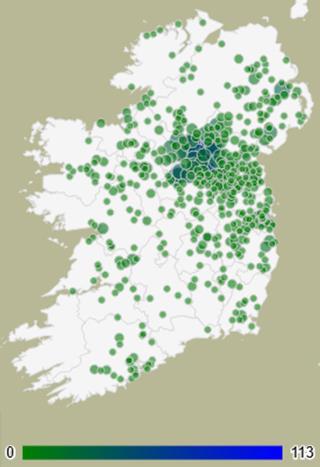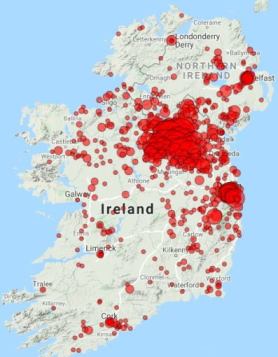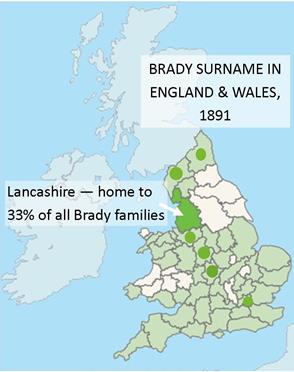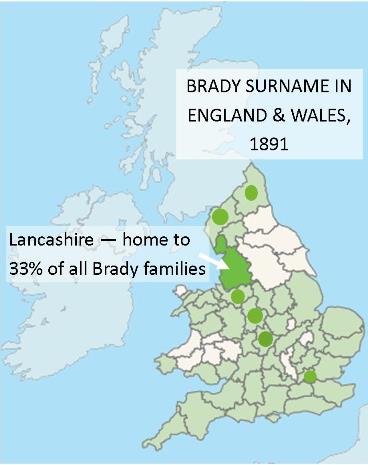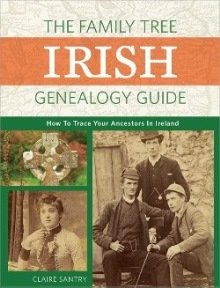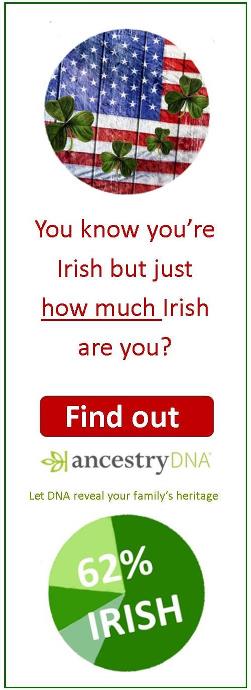- Home ›
- Irish names ›
- The Power Surname
The Brady Bunch
You're certainly showing your age if you remember The Brady Bunch, a 1970s American sitcom about the trials and tribulations and compromises of a 'blended' family with six children.
I was probably a surly teenager when it eventually crossed the Atlantic and I absolutely did not take to these syrup-y youngsters. In any case, we had seven kids in our family; what was the big deal? I simply (and rather determindly) failed to recognise the humour.
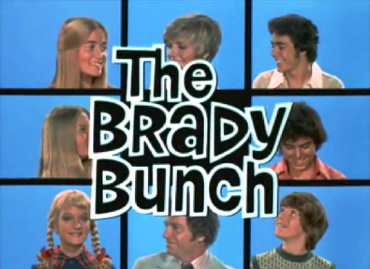 Now considered an American cultural icon, the Brady Bunch was an early 1970s TV sitcom shown on both side of the Atlantic.
Now considered an American cultural icon, the Brady Bunch was an early 1970s TV sitcom shown on both side of the Atlantic.In fact, the name of my grandmother's bossy bestie - Bridie Brady - seemed funnier to me than anything in the TV programme. My younger siblings enjoyed the show, though, and there's no denying its huge popularity over the years.
Origins of the Irish surname Brady
This family name comes from Mac Brádaigh, meaning son of Brádaigh, a
personal name thought to derive from the Old Irish word 'bradach'
meaning 'spirited', usually with argumentative or fiery connotations.
The
earliest surviving records of the anglicised surname date to 1396, when
Gilbert MacBrady became Bishop of Ardagh, and to 1454 when Andrew
MacBrady, the first Bishop of Kilmore, created a cathedral church dedicated to Saint Felimy,
or Feidhlimidh, from a 6th-century parish church in Kilmore, County Cavan. This area had been previously known as East Breifne.
This area in the Gaelic Kingdom of Breifne is the origin of the Irish surname Brady and the holders were originally a fairly distinct sept in these parts. A separate group of Bradys were originally O'Gradys and hailed County Limerick/Clare, but were not as numerous as those from Breifne.
Moving on to the mid-18th, the main group of Bradys still favour their old stamping grounds. The map above shows the location of the 2,643 Brady families across the island and you can readily identify their base in County Cavan.
Nearly two of every five Bradys in Ireland just after the Great Famine called Cavan home.
In descending order, other large concentrations of Bradys were in counties Meath (201 households), Longford (177), and Monaghan (135). Click the image to find out more.
Even half a century later, the Brady surname remains a prominent and common surname in these same areas. There had been a bit of migration westwards and job opportunities in Dublin and Belfast were a significant attraction, but most remained true to the lands of their ancestors.
 Brady's of Arklow, Co Wexford.
Brady's of Arklow, Co Wexford.You're certainly showing your age if you remember The Brady Bunch, a 1970s American sitcom about the trials and tribulations and compromises of a 'blended' family with six children.
 Now considered an American cultural icon, the Brady Bunch was an early 1970s TV sitcom shown on both side of the Atlantic.
Now considered an American cultural icon, the Brady Bunch was an early 1970s TV sitcom shown on both side of the Atlantic.I was probably a surly teenager when it eventually crossed the Atlantic and I absolutely did not take to these syrup-y youngsters. In any case, we had seven kids in our family; what was the big deal? I simply (and rather determindly) failed to recognise the humour.
In fact, the name of my grandmother's bossy bestfriend - Bridie Brady - seemed funnier to me than anything in the TV programme. My younger siblings enjoyed the show, though, and there's no denying its huge popularity over the years.
Origins of the Irish surname Brady
This family name comes from Mac Brádaigh, meaning son of Brádaigh, a personal name thought to derive from the Old Irish word 'bradach' meaning 'spirited', usually with argumentative or fiery connotations.
The earliest surviving records of the anglicised surname date to 1396, when Gilbert MacBrady became Bishop of Ardagh, and to 1454 when Andrew MacBrady, the first Bishop of Kilmore, developed the remains of a 6th-century parish church into a cathedral church dedicated to Saint Felimy, or Feidhlimidh.
This area in the Gaelic Kingdom of Breifne is the origin of the Irish surname Brady and the holders were originally a fairly distinct sept in these parts. A separate group of Bradys were originally O'Gradys and hailed from County Limerick/Clare, but were not as numerous as those from Breifne.
Moving on to the mid-18th, the main group of Bradys still favoured their old stamping grounds. The map, left, shows the location of the 2,643 Brady families across the island and you can readily identify that the most dense group is centred on County Cavan.
Nearly two of every five Bradys living in Ireland just after the Great Famine called Cavan home. In descending order, other large concentrations of Bradys were in counties Meath (201 households), Longford (177), and Monaghan (135). Click the map above to find out more.
Even half a century later, when the 1901 Irish Census was taken, the Brady surname remains a prominent and common surname in these same areas. There had been a bit of migration westwards and Dublin and the Belfast corridor still held a draw, but most remained true to the lands of their ancestors.
The Brady surname goes global
The census of 1891 recorded a total of 1,416 Brady families living in Lancashire, some 33% of all families with this surname in England and Wales at that time. The county appears in mid-green in the map below.
The counties identified in paler green are those with at least a sprinkling of Bradys, and I have added a mid-green dot to highlight those with between 2-5% of the total number of Bradys. Those in white had none.
Ignoring London, which, as a bustling metropolis you would expect to be a magnet for migrants seeking work (and was home to 13% of all Brady families), a striking pattern of residence appears across the far north and western counties of England.
Head north out of Lancashire into Cumbria and Northumberland or head south into Cheshire, Staffordshire and Warwickshire, and you find 47% - 1,986 - of all Bradys in England and Wales in the penultimate decade of the 19th century.
Not shown on this map are the Brady numbers for Scotland. They totalled 1,401 individuals (not families) in 1891, some 434 of them born in Ireland, and the majority were in Lanarkshire.
Click the image to see the original interactive map on Ancestry UK and view the statistics for each individual county.
Irish Emigration
Migration to England, and to a lesser extent Scotland, was often considered a temporary step on a long journey towards emigration to North America. Many unskilled Irish men and women took the view that if they could find work in Britain, save money for the fare and then head across the Atlantic, they would make their fortune.
There are several pages on this website that tell the story of emigration to Canada, the United States, and to Britain. If your Brady family immigrated to these destinations, these pages are worth reading to better understand their motivations and the practical challenges they experienced. You will also find details of the main genealogy records to consult in these countires.
See the Emigration section of this site.
Just over 23,000 Bradys were recorded in the United States in 1880, according to the Federal census taken in that year. They were spread across all states except Hawaii, but their numbers were tiny except for the main groupings in New York (5,106), Pennsylvania (2,654), Massachusetts (1,416), and New Jersey (1,179), followed by around a thousand each in Ohio, Illinois and Missouri, which accounted for at least 60% of the total.
Bradys in Canada
There were just 1,231 Brady families living in Canada in 1911. Of these, 741 lived in Ontario, while 190 lived in Quebec.
By the time of the 1920 census, the numbers of Bradys had grown by nearly 50% to 38,249.
New York was still the top location, with 6,403 individuals, followed by Pennsylvania (3,690), Massachusetts (2,226), Illinois (2,323), New Jersey (1,965), Ohio (1,548), California (1,232), and Missouri (1,089).
In 2010, Brady was the 450th most common name in the US, with 73,145 individuals recorded in the census that year.
There were no O'Bradys and no MacBradys, but there were 206 people with the surname McBrady and the same number spelling the surname Bradey
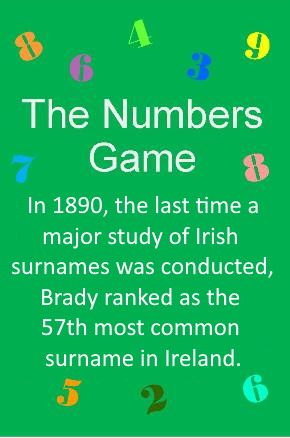
And so to Australia, where there are no census records available to search, so providing an estimate of the numbers of Bradys living there historically isn't really possible. And the only option for an estimate in current times is through White Pages, which is based on telephone directories that nowadays don't tell an accurate story.
Nonetheless, in the absence of any other figures, here are the number of entries for people with the surname Brady in each area of Australia.
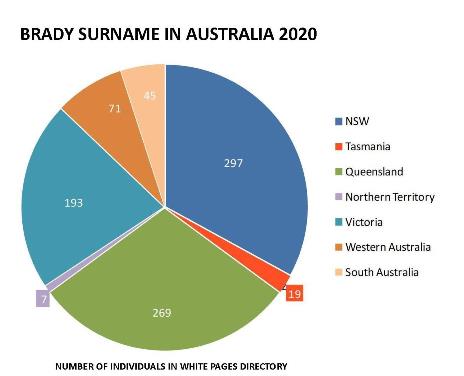
Matthew Brady - The Gentleman Bushranger
On Thursday 4 May 1826, a young man from Manchester, the son of Irish Catholic immigrants (from County Cavan, by some accounts) was hanged in Hobart Gaol in what is now known as Tasmania.
Born in 1799, Matthew Brady had been found guilty of forgery in England in 1820 and sentenced to seven years transportation to Van Dieman's Land. He wasn't your average young criminal of the day. He could read and write, had excellent horse riding skills (for this reason he is often recorded as a groom), and was a great hit with the ladies because not only was he good-looking, he never swore in their presence. Well, thats how the story goes.
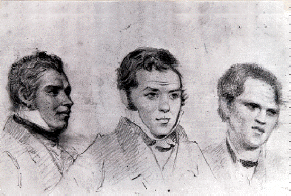 Matthew Brady (centre) with two of his collaborators, at their trial in Hobart, May 1826.
Matthew Brady (centre) with two of his collaborators, at their trial in Hobart, May 1826.He arrived in Australia on the ship Juliana and within no time was causing the prison authorities problems with his refusal to follow rules. He and a group of prisoners escaped in June 1824 and spent nearly two years on the run, living as bushrangers. Brady stood out from the band of thieves for his calm and polite manner when engaged in robbery, hence his sobriquet of Gentleman Bushranger.
His luck ran out
when he and some of his group were betrayed by one of their own.
Captured by a bounty hunter, he was tried and found guilty in the Hobart
Courthouse. On the eve of his execution, which was reported in the Colonial Times & Tasmanian Advertiser, the ladies of Hobart brought gifts, cakes, wine and flowers to his cell.
The Brady surname goes global
The census of 1891 recorded a total of 1,416 Brady families living in Lancashire, some 33% of all families with this surname in England and Wales at that time. The county appears in mid-green in the map below.
The counties identified in paler green are those with at least a sprinkling of Bradys, and I have added a mid-green dot to highlight those with between 2-5% of the total number of Bradys. Those in white had none.
Ignoring London, which, as a bustling metropolis you would expect to be a magnet for migrants seeking work (and was home to 13% of all Brady families), a striking pattern of residence appears across the far north and western counties of England.
Head north out of Lancashire into Cumbria and Northumberland or head south into Cheshire, Staffordshire and Warwickshire, and you find 47% - 1,986 - of all Bradys in England and Wales in the penultimate decade of the 19th century.
Not shown on this map are the Brady numbers for Scotland.
They totalled 1,401 individuals (not families) in 1891, some 434 of
them born in Ireland, and the majority were in Lanarkshire.
Click the image to see the original interactive map on Ancestry UK and view the statistics for each individual county.
Irish Emigration
Migration to England, and to a lesser extent Scotland, was often considered a temporary step on a long journey towards emigration to North America. Many unskilled Irish men and women took the view that if they could find work in Britain, save money for the fare and then head across the Atlantic, they would make their fortune.
There are several pages on this website that tell the story of emigration to Canada, the United States, and to Britain. If your Brady family immigrated to these destinations, these pages are worth reading to better understand their motivations and the practical challenges they experienced. You will also find details of the main genealogy records to consult in these countires.
See the Emigration section of this site.
Just over 23,000 Bradys were recorded in the United States in 1880, according to the Federal census taken in that year. They were spread across all states except Hawaii, but their numbers were tiny except for the main groupings in New York (5,106), Pennsylvania (2,654), Massachusetts (1,416), and New Jersey (1,179), followed by around a thousand each in Ohio, Illinois and Missouri, which accounted for at least 60% of the total.
Bradys in Canada
There were just 1,231 Brady families living in Canada in 1911. Of these, 741 lived in Ontario, while 190 lived in Quebec.
By the time of the 1920 census, the numbers of Bradys had grown by nearly 50% to 38,249.
New York was still the top location, with 6,403 individuals, followed by Pennsylvania (3,690), Massachusetts (2,226), Illinois (2,323), New Jersey (1,965), Ohio (1,548), California (1,232), and Missouri (1,089).
In 2010, Brady was the 450th most common name in the US, with 73,145 individuals recorded in the census that year.
There were no O'Bradys and no MacBradys, but there were 206 people with the surname McBrady and the same number spelling the surname Bradey.
Now we head to Australia, where there are no census records available to search, so providing an estimate of the numbers of Bradys living there historically isn't really possible. And the only option for an estimate in current times is through White Pages, which is based on telephone directories that nowadays don't tell an accurate story.
Nonetheless, in the absence of any other figures, here are the number of entries for people with the surname Brady in each area of Australia.

Matthew Brady - The Gentleman Bushranger
On Thursday 4 May 1826, a young man from Manchester, the son of Irish Catholic immigrants (from County Cavan, by some accounts) was hanged in Hobart Gaol in what is now known as Tasmania.
Born in 1799, Matthew Brady had been found guilty of forgery in England in 1820 and sentenced to seven years transportation to Van Dieman's Land. He wasn't your average young criminal of the day. He could read and write, had excellent horse riding skills (for this reason he is often recorded as a groom), and was a great hit with the ladies because not only was he good-looking, he never swore in their presence. Well, thats how the story goes.
 Matthew Brady (centre) with two of his collaborators, at their trial in Hobart, May 1826.
Matthew Brady (centre) with two of his collaborators, at their trial in Hobart, May 1826.He arrived in Australia on the ship Juliana and within no time was causing the prison authorities problems with his refusal to follow rules. He and a group of prisoners escaped in June 1824 and spent nearly two years on the run, living as bushrangers.
Brady stood out from the band of thieves for his calm and polite manner when engaged in robbery, hence his sobriquet of Gentleman Bushranger.
His luck ran out
when he and some of his group were betrayed by one of their own.
Captured by a bounty hunter, he was tried and found guilty of murder in Hobart
Courthouse. On the eve of his execution, which was reported in the Colonial Times & Tasmanian Advertiser, the ladies of Hobart brought gifts, cakes, wine and flowers to his cell.
